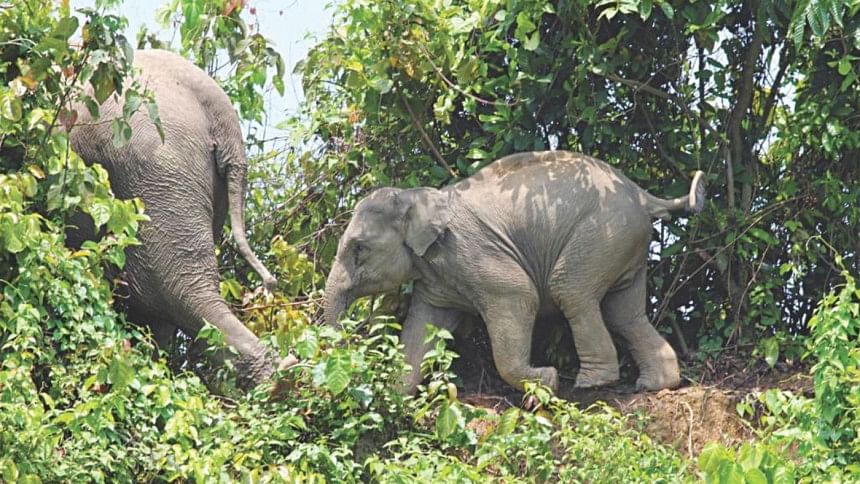Shrinking wild spaces and the growing conflict between humans and animals

Like writer-journalist Jon Mooallem wrote in "Wild Ones", I too have been finding nature in the oddest of places. This, especially so during this long-drawn-out pandemic, while I remained mostly holed up in one of the most nature-unfriendly cities in the world (if I may say so). Bears have appeared on my pyjamas, which I have refused to get out of as the pandemic stretched on and on. Tigers are seen on the tip of my toothbrush. Elephants and sloths roam the wild in the animated movie I keep playing in a loop because it's comforting. In terms of actual wildlife, though, I have seen the occasional Lesser Golden-backed Woodpecker.
In the meantime, work has continued—mostly from home—and as a copy editor with a background in environmental science who receives stories from around the country, I could not help but note the sheer volume of human-animal conflict stories. I am beating myself up for not keeping an exact count, but a quick search on The Daily Star's website reveals that there are way too many stories of humans being trampled to death by elephants. Now, elephants in general are not human predators. They do not eat us for food and are considered gentle. But they can kill, when provoked, when we come in their way, when they are stressed, harassed or are looking for food and you happen to be in the way. In the hill districts, this seems to be happening way too often to be ignored. Which brings me to the issue of growing human-wildlife conflict.
This is not a case that involves just elephants. In the hill districts of Bangladesh, namely Bandarban, Rangamati and Khagrachhari and parts of Chattogram and Cox's Bazar, the cases of conflict happen to be more with elephants. This is because these areas are considered to be among the last habitats of the Asian elephant, a species that has been driven to near extinction thanks to habitat destruction, degradation and indiscriminate hunting, among many of the myriad reasons. Most recently, the corridor used by Asian elephants for migration—something that is entrenched in their memory and cannot be just changed overnight—was slowly closed up by the Rohingya refugee camps. This meant that a part of the elephant population got stuck on the Bangladesh side of the forests and the rest remained in the forests on the other side of the border, likely in India and Myanmar. For a species with a declining population, this meant further isolation, further restriction of genetic diversity and an overall immense distress to these gentle giants, who need a vast area for foraging, roaming, finding food, and mating.
While stories of conflict between elephants and humans kept coming from the south-eastern region of the country, other places in Bangladesh were not far behind. In the eastern Sylhet regions and even in the north-west, stories of fishing cats, slow loris and civets venturing into human territory, being caught up and brutally beaten, are far too common as well. And very recently, I was handed a story of a python that was caught in the nets of a maize field. It was luckily rescued by the farmer who, to my utter surprise, did not get intimidated and immediately beat up the poor reptile. Maybe compassion is still alive. He cut up the nets, rescued the animal which he believed had slithered in from bordering India in search of food, and handed the nearly six-feet-long python to members of the forest department, who then released the animal into the wild.
The point here is, a python does not need rescuing. They are supposed to move long distances. Animals do that. Migration and movement, even in humans, was a common practice before we had somehow managed to climb up the food web very quickly and very decisively to change the course of nature entirely.
This can be explained by the alarming decline in forest cover. According to Global Forest Watch, from 2002 to 2020, Bangladesh lost 7.03 Kha (kilo hectare) of humid primary forest, making up 3.7 percent of its total tree cover loss in the same time period. The total area of humid primary forest in Bangladesh decreased by 7.3 percent in this time period. In 2010, Bangladesh had 2.22 Mha (mega hectare) of tree cover, extending over 16 percent of its land area, and by 2020, it lost 21.5 Kha of tree cover, equivalent to 11.6 metric tonnes of CO2e (Carbon dioxide equivalent) of emissions.
Meanwhile, according to older reports, the per capita forest area in Bangladesh is less than 0.015 hectare (Islam 2013) against the world average of 0.6 hectare (FAO, 2010). And according to a recent TIB statement quoting the United Nations Food and Agriculture Organization, the annual deforestation rate in Bangladesh is almost double the global average—2.6 percent.
Our monumental rise to the top has removed nature's regular checks and balances. And that has spelled disaster for the order of the natural world. Never before have we faced extinction of so many species at so quick a rate.
Bangladesh, while being a tropical country, should be extremely rich in biodiversity, and on paper it is, but with shrinking natural habitats and a growing population constantly vying for resources, biodiversity has taken a hit. Bangladesh's most extensive database on biodiversity was conducted by the International Union for Conservation of Nature's last animal Red List of Bangladesh (2015), which was funded by the World Bank. In that exercise, 160 biologists rigorously assessed 1,619 species of mammal, bird, reptile, amphibian, freshwater fish, crustacea and butterflies. Alarmingly, about 24 percent of these species were found to be threatened.
Even the pandemic could not stop the rate of our destruction of the planet. According to the National Space Research Institute of Brazil, more than 1,200 square kilometres of the Amazon rainforest—an area that is ten times larger than Dhaka city—were destroyed from January to April in 2020 during the ongoing pandemic. This deforestation is 55 percent more than that during the same period of 2019. A recent Greenpeace report has already warned that the Amazon may become the source of the next zoonotic pandemic.
To explain the extent of the damage and the surreal picture of wildlife, I will have to go back to the wise words of Jon Mooallem in his seminal piece of work: "We are living in the eye of a great storm of extinction, on a planet haemorrhaging living things so fast that half of its nine million species could be gone by the end of the century… As our own species has taken over, we've tried to retain space for at least some of the others being pushed aside, shoring up their chances of survival."
The only chance for the wild to survive and revert back from extinction happens to be with our intervention. In fact, J Michael Scott, an American government biologist, was quoted as saying in "Wild Ones": "Right now, nature is unable to stand on its own."
Unfortunately, the very species—aka us—responsible for driving so many animals towards extinction, plundering through vital ecosystems and continuously destroying and degrading habitats, also happen to be the ones that possibly can change the course of this tide and be responsible for conservation of nature.
Being cooped up in our homes and watching nature simply in fantastically shot documentaries or reading about it fails to drive home the point that our planet could very well go on without us. It is us who need biodiversity and wild spaces to continue to exist and flourish—for the mind and for the body.
Historian Joanna Bourke wrote it best in her reflections in the book "What It Means to Be Human": "Erasing the awe-inspiring variety of sentient life impoverishes all our lives."
We have brought the world to a stage where the plunderers, who need and rely so much on the natural world for food, shelter, sustenance and medication, will have to sow the seeds of rejuvenation. And it is not a choice anymore, because humans cannot afford to count yet another loss.
Abida R Chowdhury is a journalist at The Daily Star.

 For all latest news, follow The Daily Star's Google News channel.
For all latest news, follow The Daily Star's Google News channel. 



Comments